2. 中国地质科学院国家地质实验测试中心, 北京 100037
2. National Research Center for Geoanalysis, Chinese Academy of Geological Sciences, Beijing 100037, China
拉萨地块作为青藏高原的重要组成部分,广泛发育中生代-新生代岩浆岩,保存了与(1)新特提斯洋壳岩石圈北向俯冲(Ji et al., 2009; Zhu et al., 2011; 徐倩等, 2019a);(2)拉萨-羌塘地块碰撞(Dewey et al., 1988; Copeland et al., 1995; Yin and Harrison, 2000; Kapp et al., 2005, 2007; Chu et al., 2006; Leier et al., 2007; Zhu et al., 2008, 2009a);和(3)印度-欧亚大陆碰撞(Yin and Harrison, 2000; 莫宣学等, 2003; Mo et al., 2008; 徐倩等, 2019a, b; Xu et al., 2020)等重要地质事件的记录。冈底斯岩基位于拉萨地块的南部,其花岗质岩石具有不同的形成时代和地球化学特征(Schärer et al., 1984; Le Fort, 1988; Mo et al., 2007; Chung et al., 2003; Hou et al., 2004; Zhu et al., 2011; Zhang et al., 2012),记录和保存了早古生代至新生代的构造演化-岩浆作用过程。但是对于冈底斯岩基的研究主要集中在中生代-新生代的岩浆作用,而晚古生代岩浆活动的研究主要集中在拉萨地块中部(耿全如等, 2007; Geng et al., 2009; Zhu et al., 2009b, 2010)。近年的研究表明,冈底斯岩基南部发育晚古生代岩浆岩,以花岗岩类岩石为主,主要分布在加查县和朗县附近(图 1b),董昕等(2010)最早在拉萨地块南缘加查县发现了晚泥盆世(~366Ma)花岗岩。随后在朗县杂岩体也发现原岩年龄为石炭纪早期(341~355Ma)的花岗质岩石(Ji et al., 2012a; Zhang et al., 2012; 吴兴源等, 2013; 王莉等, 2013; Dong et al., 2014),此外,在日喀则西部的雄村还报道了早石炭世(~341Ma)的辉长岩(郎兴海等, 2017)。但是对于这期岩浆作用的岩浆来源、岩石成因和动力学背景存在不同观点,吴兴源等(2013)认为朗县石炭纪花岗岩为高温S型花岗岩,由地壳物质的重熔以及幔源的混入形成。也有观点表示这类花岗岩为I型,来自古元古代基底的再造(Ji et al., 2012a),还有报道这些花岗岩侵入体具有双峰式火山岩的特点,形成于弧后伸展环境(Dong et al., 2014)。
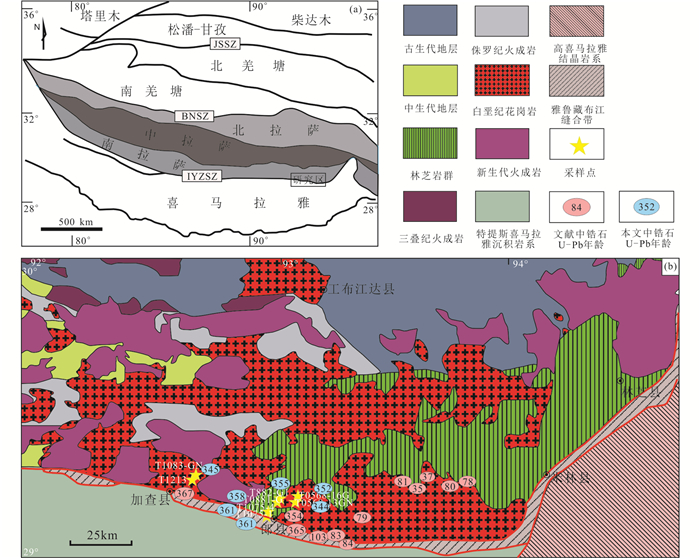
|
图 1 藏南冈底斯岩基东段地质简图 (a)青藏高原大地构造单元划分图(据朱弟成等, 2012修改);(b)研究区地质简图(据董昕等, 2010修改). JSSZ-金沙江缝合带;BNSZ-班公湖-怒江缝合带;IYZSZ-印度河-雅鲁藏布江缝合带.锆石U-Pb数据引自Wen et al., 2008a, b; Zhang et al., 2010; 董昕等, 2010; 管琪等, 2010; Guan et al., 2012; Ji et al., 2012a; 王莉等, 2013; 吴兴源等, 2013; Dong et al., 2014 Fig. 1 Simplified geological map in the eastern part of Gangdese batholith, southern Tibet (a) geological sketch map of tectonic outline of the Tibetan Plateau; (b) geological map of the studied area. JSSZ-Jinsha Suture Zone; BNSZ-Bangong-Nujiang Suture Zone; IYZSZ-Indus-Yarlung Zangbo Suture Zone. Literature data after Wen et al., 2008a, b; Zhang et al., 2010; Dong et al., 2010, 2014; Guan et al., 2010, 2012; Ji et al., 2012a; Wang et al., 2013; Wu et al., 2013 |
本文以藏南加查县和朗县地区出露的泥盆纪-石炭纪花岗岩为研究对象,在锆石U-Pb年龄、全岩主要元素和微量元素数据基础上,综合现有的文献资料,来揭示该阶段岩浆作用的时限和地球化学特征,探讨其岩浆源区和岩石成因,进一步完善冈底斯岩基东段的晚古生代岩浆作用过程,提高对拉萨地块古生代演化历史的认识。
1 地质背景和样品青藏高原自北向南由一系列构造地块组成,大致分为四地块三带的格局,分别为松潘-甘孜地块、羌塘地块、拉萨地块和喜马拉雅地块,分别以金沙江缝合带(JSSZ)、班公湖-怒江缝合带(BNSZ)和印度河-雅鲁藏布江缝合带(IYZSZ)为界(图 1a; Yin and Harrison, 2000)。其中,拉萨地块位于雅鲁藏布江缝合带和班公湖-怒江缝合带之间,呈东西向展布,其长约2500km,宽约150~300km,是一条巨型的构造-岩浆岩带(图 1a)。冈底斯岩基沿着拉萨地块的南缘自西向东出露,从西部冈仁波齐峰往东延伸到南迦巴瓦峰,雅鲁藏布江缝合带为其南部边界。冈底斯弧是新特提斯洋壳向拉萨地块俯冲以及随后印度/欧亚板块碰撞的结果(Tapponnier et al., 1981)。冈底斯弧主要由晚三叠世至始新世的钙碱质花岗岩岩基组成(图 1b; Debon et al., 1986; Chung et al., 2005; Wen et al., 2008a, b; Ji et al., 2009)。出露的火山岩包括早-中侏罗世叶巴组火山岩(Zhu et al., 2008),早侏罗世-早白垩世桑日群火山岩(Zhu et al., 2009b; Kang et al., 2014)以及晚白垩世-始新世(68~43Ma)林子宗群火山岩(图 1b; He et al., 2007)。新生代岩浆作用表现为钾质-超钾质岩浆岩(Zhao et al., 2009; Guo and Wilson, 2019)和高Sr/Y比中-酸性岩浆岩(Chung et al., 2003, 2005; Hou et al., 2004, 2015; 徐倩等, 2019b)。
本文的研究区位于冈底斯岩基东段(拉萨地块东南缘)的加查县和朗县附近(图 1b),研究区包含3个构造单元,从北向南依次为:冈底斯弧、雅鲁藏布江缝合带和特提斯喜马拉雅带(图 1a)。区内出露少量晚侏罗世多底沟组、白垩纪朗县混杂岩和渐新世-中新世大竹卡组岩石。研究区内花岗岩类主要形成于晚白垩世(图 1b; Quidelleur et al., 1997; Wen et al., 2008a, b; 管琪等, 2010),零星发育始新世花岗岩(Guan et al., 2012; Ji et al., 2012b)。采样地点位于加查县东北和朗县县城北部(图 1b)。样品包括两类:朗县韧性剪切带中的砾石(T1075-1和T1075-4)和区域断续出露的花岗片麻岩(T0568-16G、T0881-G、T0568-13GN、T1083-GN1、T1213和T0882-G1)(图 2、表 1),这些花岗质岩石以岩体(加查县)、巨型砾石(朗县杂岩)等形式出露,具有斑状结构或眼球状以及中粒-粗粒粒状结构,部分花岗片麻岩可见明显的塑性变形特征(图 2c, e)。主要由斜长石(25%~30%)、钾长石(20%~25%)、石英(20%~25%)和黑云母(10%~15%)组成,斜长石大小和形态多样,可见波状消光(图 2f),部分样品中钾长石以巨大斑晶形式产出并具有定向性(图 2a, b);石英颗粒形态不一,有的呈细小的颗粒状成群分布或以较大颗粒存在(图 2d),有的以条带状展布,显示塑性变形特征,具有波状消光;黑云母主要以细小针状或者短柱状存在。
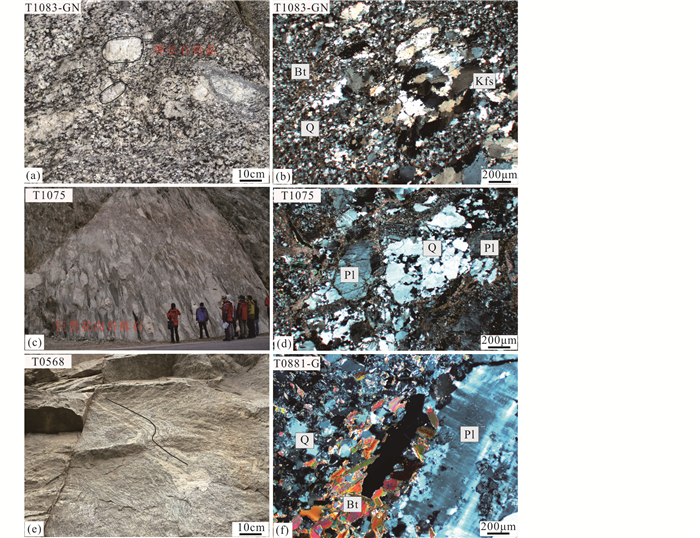
|
图 2 加查县和朗县石炭纪花岗岩类野外露头和显微照片 (a、b)加查岩体中含钾长石巨斑晶的花岗片麻岩;(c、d)朗县杂岩巨型花岗岩砾石;(e)朗县杂岩中变形的花岗片麻岩;(f)朗县杂岩中花岗斑岩. Q-石英;Pl-斜长石;Bt-黑云母;Kfs-钾长石 Fig. 2 Field photos and microphotographs of Carboniferous granodiorite in Jiacha and Lang(a, b) the granitic gneiss with giant K-feldspar in Jiacha pluton; (c, d) giant granite gravel of Langxian complex; (e) deformed granitic gneiss; (f) granodioritic porphyre. Q-quartz; Pl-plagioclase; Bt-biotite; Kfs-K-feldspar |
|
|
表 1 藏南冈底斯岩基东段野外样品主要信息 Table 1 Field samples of the eastern in Gangdese batholith, southern Tibet |
为确定加查岩体和朗县杂岩中花岗岩类的形成时代,通过手工挑选出研究样品中的锆石,经过制靶和抛光,在显微镜下进行透反射照相,进一步拍摄锆石的扫描电镜背散射(BSE)和阴极发光(CL)图像进行观察和选点。CL成像在中国地质科学院地质研究所北京离子探针中心完成,扫描电镜背散射(BSE)图像、透反射照相和锆石内部包裹体成分分析在中国地质科学院地质研究所自然资源部深部动力学重点实验室获得。结合透反射图像、CL图像和BSE图像中锆石的特征,避开裂隙发育部位,选取锆石中合适的点位进行U-Pb年龄测试。
为获得所研究样品的锆石U-Pb年龄,利用LA-MC-ICP-MS和SHRIMP进行测试分析。其中对朗县杂岩和加查岩体采集的样品(T1075-1、T1075-4、T0881-G、T0568-16G、T0568-13GN和T1083-GN1)进行LA-MC-ICP-MS锆石U-Pb定年。测试工作在中国地质科学院矿产资源研究所成矿作用与资源评价重点实验室进行,所用仪器为德国Finnigan公司生产的Neptune型激光多接收等离子体质谱(LA-MC-ICPMS)。激光剥蚀系统采用美国NEW Wave公司生产的UP213nm,所用斑束直径为25μm,频率为10Hz,能量密度约为2.5J/cm2,以He为载气。U和Th含量以锆石标样M127(U=923×10-6;Th/U=0.475)为外标进行校正。在测试过程中,每测定10个样品点前后重复测量两次锆石标样GJ-1和一次锆石标样Plesovice。分析数据的离线处理(包括对样品和空白信号的选择、仪器灵敏度漂移校正、元素含量及U-Th-Pb同位素比值和年龄计算)采用软件ICPMSDataCal完成(Liu et al., 2010)。对朗县杂岩中1件花岗片麻岩样品(T0882-G1)进行SHRIMP锆石U-Pb同位素定年。测试工作在北京离子探针中心进行,所用仪器为高分辨率、高灵敏度离子探针SHRIMP Ⅱ。分析时所用标样为TEM锆石,每测定3个样品点,进行一次标样测定,以便及时校正,保障测试精度。数据分析处理和年龄计算等利用ISOPLOT程序(Ludwig, 2003)。
2.2 全岩地球化学分析为查明藏南冈底斯岩基东段加查岩体和朗县杂岩中花岗岩类的地球化学特征,本文中样品的全岩主、微量元素的测试工作在自然资源部国家地质实验测试中心进行。主量元素利用XRF(X荧光光谱仪3080E)方法进行测试,分析精度为5%;微量和稀土元素(REE)采用等离子质谱仪(ICP-MS-Excell)分析完成,对于含量大于10×10-6的元素,分析精度为5%,含量小于10×10-6的元素,精度为10%,样品中个别含量低的元素测试误差大于10%。
3 数据及结果 3.1 全岩地球化学特征根据主量元素地球化学特征将本文所测试的石炭纪花岗岩类分为两组(表 2),第一组:SiO2含量(68.12%~75.33%)、Na2O含量(2.33%~3.79%)、K2O含量(3.21%~5.49%),K2O/Na2O较高,均>1(1.09~1.88)(图 3d),CaO含量(0.79%~3.71%),FeO和MgO的平均含量分别为1.77%和0.90%,TiO2和MnO含量较低,分别 < 0.44%和 < 0.08%,Al2O3含量为12.66%~14.98%,铝饱和指数(A/CNK=0.99~1.10)和CIPW标准矿物中的刚玉分子数(0.9%~1.53%),该组岩石为富钾弱过铝质碱性花岗岩(图 3a-c);第二组:SiO2含量(67.46%~74.14%)、Na2O含量(3.24%~4.73%)、K2O含量(1.97%~3.22%),K2O/Na2O较低,均 < 1(0.42~0.99)(图 3d),CaO含量相对变化较小(0.98%~4.32%),FeO和MgO的平均含量分别为2.31%和1.23%,TiO2和MnO含量较低,分别 < 0.47%和 < 0.08%,Al2O3含量为13.20%~15.82%,铝饱和指数(A/CNK=0.98~1.18)(图 3b)和CIPW标准矿物中的刚玉分子数(0.75%~2.28%),表明这一组岩石具有富钠弱过铝-强过铝质花岗岩的特征(图 3a, b)。此外,这两组花岗质岩石的SiO2与TiO2、Al2O3、MnO、MgO、CaO、P2O5具有明显的线性关系(图 4a-f)。
|
|
表 2 冈底斯岩基东段石炭纪花岗岩样品全岩地球化学数据(主量元素:wt%;稀土和微量元素:×10-6) Table 2 Whole-rock geochemical data of the Carboniferous granitoids from the eastern of Gangdese batholith, southern Tibet (major elements: wt%; trace elements: ×10-6) |
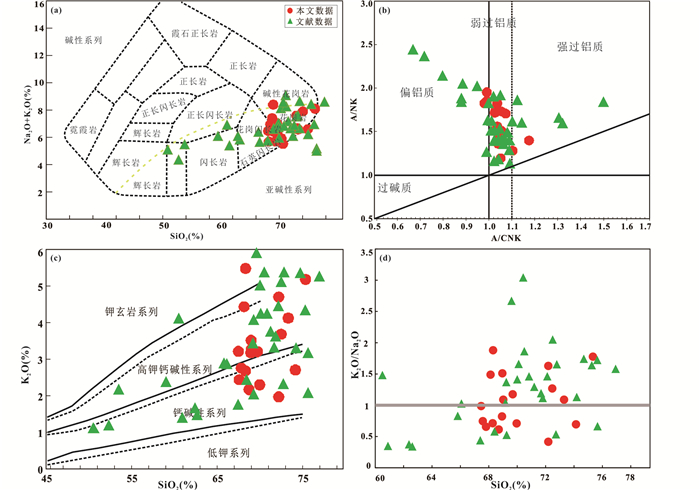
|
图 3 冈底斯岩基东段石炭纪花岗岩类地球化学特征图解 (a) TAS分类图解(据Wilson, 1989);(b) A/CNK-A/NK图解(据Maniar and Piccoli, 1989);(c) SiO2-K2O图解(据Rollinson, 1993);(d) SiO2-K2O/Na2O图解.文献数据引自Ji et al., 2012a; 王莉等, 2013; 吴兴源等, 2013; Dong et al., 2014;图 4、图 5、图 8、图 9同 Fig. 3 Geochemical diagrams of the Early Carboniferous granitoids from eastern part of Gangdese batholiths (a) Total alkalis vs. silica diagram (after Wilson, 1989); (b) A/NK vs. A/CNK diagram (after Maniar and Piccoli, 1989); (c) K2O vs. SiO2 diagram (after Rollinson, 1993) (d) SiO2 vs. K2O/Na2O diagram. Literature data from Ji et al., 2012a; Wang et al., 2013; Wu et al., 2013; Dong et al., 2014; also in Fig. 4, Fig. 5, Fig. 8 and Fig. 9 |

|
图 4 加查县和朗县石炭纪花岗质岩石地球化学特征 Fig. 4 Covariation diagram of selected major oxides of TiO, Al2O3, MnO, MgO, CaO, P2O5 versus SiO2 in Jiacha and Lang Early Carboniferous granitoids |
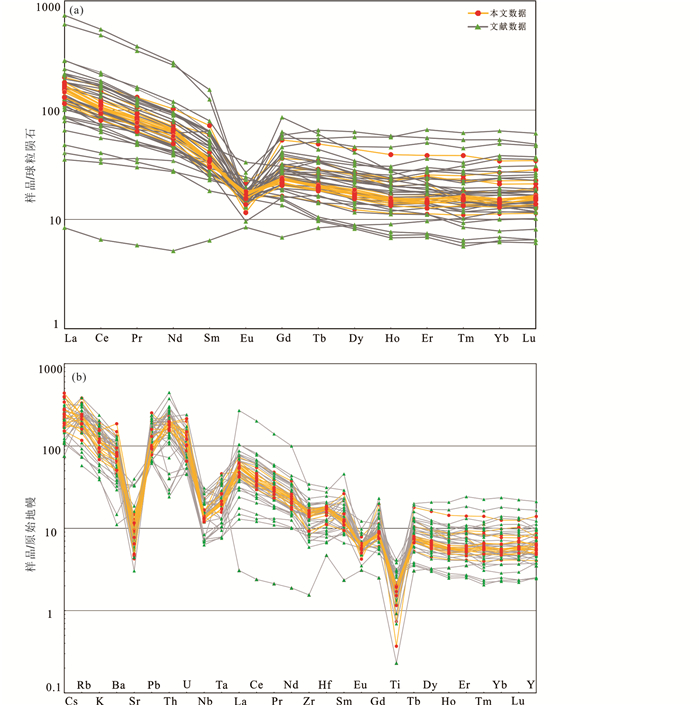
|
图 5 冈底斯岩基东段花岗质岩石球粒陨石标准化稀土元素模式图(a)和原始地幔标准化微量元素蜘蛛图(b)(标准化值据McDonough and Sun, 1995) Fig. 5 Chondrite-normalized REE patterns (a) and primitive mantle-normalized trace element spider diagrams (b)(normalization values after McDonough and Sun, 1995) of the Early Carboniferous granitoids from eastern part of Gangdese batholith |
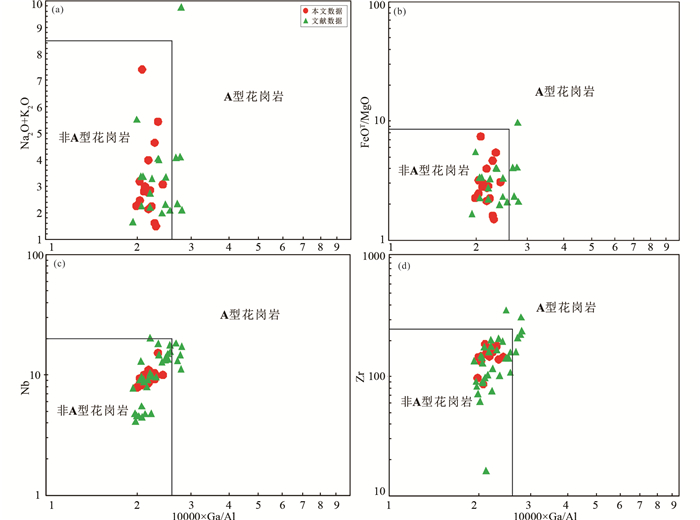
|
图 8 冈底斯岩基东段石炭纪A型花岗岩判别图(据Whalen et al., 1987) (a) Na2O+K2O-10000×Ga/Al图解;(b) FeOT/MgO-10000×Ga/Al图解;(c) Nb-10000×Ga/Al图解;(d) Zr-10000×Ga/Al图解 Fig. 8 Petrogenesis discriminant diagrams of Carboniferous A-type granite of the eastern Gangdese batholith (after Whalen et al., 1987) (a) Na2O+K2O vs. 10000×Ga/Al diagram; (b) FeOT/MgO vs. 10000×Ga/Al diagram; (c) Nb vs. 10000×Ga/Al diagram; (d) Zr vs. 10000×Ga/Al diagram |

|
图 9 冈底斯岩基东段石炭纪花岗岩构造环境微量元素判别图解(据Pearce et al., 1984) (a) Nb-Y图解;(b) Rb-Y+Nb图解;(c) Ta-Yb图解;(d) Rb-Y+Ta图解 Fig. 9 Discriminant diagrams of trace elements in the tectonic environment of Carboniferous granite from eastern part of Gangdese batholiths (a) Nb vs. Y diagram; (b) Rb vs. Y+Nb diagram; (c) Ta vs. Yb diagram; (d) Rb vs. Y+Ta diagram |
微量元素特征:第一组样品富集大离子亲石元素(如Cs、Rb、K、Ba和Pb),其中Ba含量较高且变化范围大(477×10-6~1229×10-6),Nb、Ta亏损,Ti强烈亏损,Zr和Hf无明显异常(图 5b、表 2),Sr含量为84.8×10-6~253×10-6,Y含量为20.7×10-6~60.0×10-6,Sr/Y=1.60~10.86,Cr含量为0.66×10-6~9.60×10-6,Ni含量为1.00×10-6~4.91×10-6;第二组样品同样富集大离子亲石元素(如Cs、Rb、Ba和Pb),其中Ba含量变化较小(308×10-6~626×10-6),Nb、Ta亏损,Ti强烈亏损,Zr和Hf无明显异常(图 5b、表 2),Sr含量为96.9×10-6~291×10-6,Y含量为17.3×10-6~27.8×10-6,Sr/Y=4.19~13.53,Cr含量为5.79×10-6~14.60×10-6,Ni含量为3.47×10-6~6.98×10-6。
稀土元素特征:第一组花岗岩稀土总量∑REE=124.9×10-6~256.7×10-6,样品富集轻稀土元素(LREE)((La/Gd)N=3.72~7.31),亏损重稀土元素(HREE)((La/Yb)N=5.08~13.55)(图 5a、表 2),从Gd-Yb稀土分布较为平坦((Gd/Yb)N=1.00~2.75),具有明显的负Eu异常(Eu/Eu*=0.24~0.69),轻重稀土分异较为明显;第二组花岗岩稀土总量较低∑REE=126.9×10-6~180.9×10-6,样品富集轻稀土元素((La/Gd)N=6.15~7.59)),亏损重稀土元素((La/Yb)N=9.05~13.29)(图 5a、表 2),从Gd-Yb稀土分布较为平直((Gd/Yb)N=1.35~1.91),Eu负异常变弱(Eu/Eu*=0.49~0.78),轻重稀土分异依然明显。
3.2 锆石U-Pb年龄本文对加查县和朗县共7件花岗岩类样品进行了锆石U-Pb定年,分析结果见表 3、表 4。在朗县花岗岩砾石样品(T1075-1和T1075-4)中的锆石具有相似的结构和形态,多为椭圆状,具有明显的振荡环带,颗粒大小为100μm(图 6a, c)。锆石的Th和U含量变化范围分别为142×10-6~1005×10-6和246×10-6~2322×10-6以及183×10-6~3467×10-6和420×10-6~3005×10-6,Th/U比值变化范围分别为0.32~0.68和0.22~1.40(表 3)。样品T1075-1获得的206Pb/238U年龄变化范围较小,年龄集中在谐和线~360Ma附近,加权平均年龄为361.9±2.5Ma(n=20,MSWD=0.63)(图 7a, b)。样品T1075-4具有相似的特点,共测试21个点,剔除4个较年轻的年龄值后获得的加权平均年龄为361.6±2.5Ma(n=17,MSWD=0.28)(图 7e, f)。
|
|
表 3 冈底斯东段石炭纪岩浆岩LA-MC-ICP-MS锆石U-Pb定年数据 Table 3 LA-MC-ICP-MS zircon U-Pb analytical results of Carboniferous magmatic rocks from eastern Gangdese |
|
|
表 4 冈底斯东段石炭纪岩浆岩SHRIMP锆石U-Pb定年数据 Table 4 SHRIMP zircon U-Pb analytical results of Carboniferous magmatic rocks from eastern Gangdese |
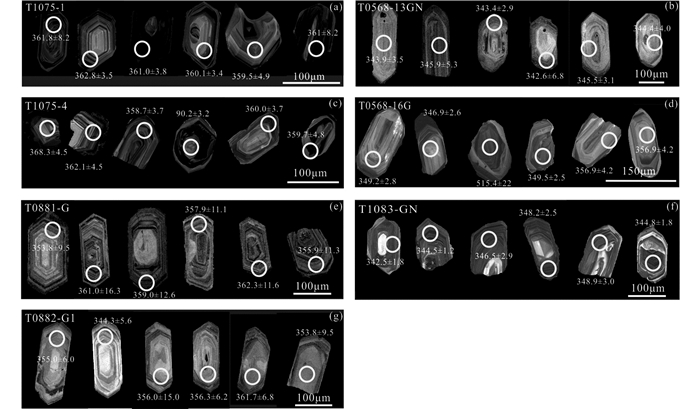
|
图 6 冈底斯岩基东段石炭纪花岗岩中锆石阴极发光图像(CL)和U-Pb定年结果 Fig. 6 Cathodoluminescence (CL) images and U-Pb analysis on zircon grains from eastern Gangdese batholith |
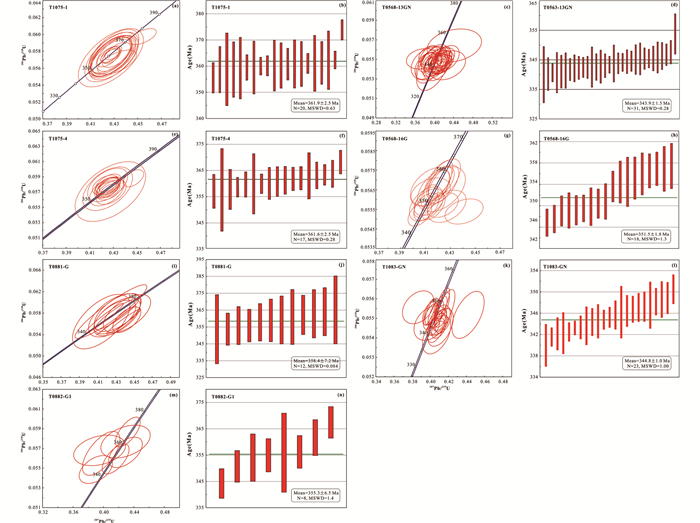
|
图 7 冈底斯岩基东段石炭纪花岗岩锆石U-Pb年龄谐和图和年龄分布图 Fig. 7 U-Pb concordia and age distribution diagrams for zircon from eastern part of Gangdese batholith |
花岗岩样品(T0881-G和T0568-16G),锆石为较规则的长柱状晶体(图 6d, e),Th和U含量分别55.4×10-6~990×10-6和191×10-6~2374×10-6以及58.1×10-6~1660×10-6和203×10-6~1738×10-6(表 3),Th/U比值变化范围分别为0.16~0.58和0.10~3.47(表 3)。样品T0881-G测试分析30个点,获得的206Pb/238U年龄变化范围较大,其中17个测点的206Pb/238U年龄变化于190~310Ma,年龄较分散。剔除1个不谐和年龄点后剩余12个测点的206Pb/238U年龄变化在谐和线~358Ma附近,加权平均年龄为358.4±7.2Ma(n=12,MSWD=0.084)(图 7i, j)。样品T0568-16G共测试30个点,其中18个点获得的206Pb/238U年龄变化较小,加权平均年龄为351.5±1.8Ma(n=18,MSWD=1.3)(图 7g, h)。其余样品点谐和性或误差较大。
花岗片麻岩(T568-13GN和T0882-G1)中的锆石多为长柱状,长宽比为2:1(图 6d, g),Th和U含量变化范围较大分别为40.1×10-6~523×10-6和127×10-6~2722×10-6以及4.3×10-6~904×10-6和12×10-6~2309×10-6,Th/U比值变化范围分别为0.09~0.63和0.10~0.75,振荡环带明显亦为典型的岩浆型锆石(图 6d, g)。样品T568-13GN测试分析40个点,其中31个点获得的206Pb/238U年龄变化较小,加权平均年龄为343.9±1.5Ma(n=31,MSWD=0.28)(图 7c, d;表 3),其余9个点年龄范围在210~276Ma。样品T0882-G1测试分析12点,其中8个点获得的206Pb/238U年龄变化较小,加权平均年龄为355.3±6.5Ma(n=8,MSWD=1.40)(图 7m, n; 表 4)。
加查县样品T1083-GN(花岗片麻岩)的锆石为长柱状晶体(图 6f),晶型不完整,Th含量为83.0×10-6~604×10-6,U含量变化范围较大172×10-6~1912×10-6(表 3),Th/U比值变化范围为0.18~2.03,具有明显的振荡环带(图 6f),为典型的岩浆成因锆石。测试分析30个点,剔除不谐和年龄及误差较大的7个分析点,23个分析点获得的206Pb/238U年龄变化较小,获得加权平均年龄为344.8±1.0Ma(n=23,MSWD=1.00)(图 7k, i)。
4 讨论 4.1 冈底斯岩基东段石炭纪岩浆作用记录本文1件加查县花岗片麻岩样品获得的锆石U-Pb年龄为344.8Ma,朗县杂岩中6件花岗岩类的锆石U-Pb年龄为344~362Ma,共同表明在冈底斯岩基东段的岩浆活动发生在晚古生代,加查岩体和朗县岩体侵位于石炭纪早期。在冈底斯岩基东段先后报道了一些晚泥盆-早石炭纪岩浆岩,董昕等(2010)首次发现了加查岩体片麻状花岗岩,其侵位时代为晚泥盆世(367Ma),之后在该地区也发现了早石炭纪的片麻状花岗闪长岩(345~347Ma)(Ji et al., 2012a)。在加查县东部的朗县地区也相继报道了早石炭纪的岩浆作用记录(341~360Ma)(Ji et al., 2012a; 王莉等, 2013; 吴兴源等, 2013)。在加查县西部的正嘎地区还报道了晚泥盆-石炭纪的角闪岩(原岩为辉长岩和闪长岩)和二云母花岗岩(Ma et al., 2019)。此外,日喀则西部的雄村发现了石炭纪的辉长岩(~341Ma)(郎兴海等, 2017),拉萨地块中部申扎他多雄地区也报道了一些基性岩(辉长岩和辉绿玢岩)(~366Ma)(吴兴源等, 2013)。在拉萨地块中部的然乌地区,报道了早石炭纪火山岩的有关记录(耿全如等, 2007)。在研究冈底斯岩基出露的二叠纪-渐新世岩浆岩以及林子宗火山岩时发现一些继承锆石的年龄在中-晚泥盆世到石炭纪末期(390~300Ma)(Chu et al., 2006; 李皓揚等, 2007; Leier et al., 2007; Zhu et al., 2009a)。此外,在研究雅鲁藏布江支流(朗县北部)现代河沙(Zhang et al., 2009)、林芝杂岩变沉积岩(Guo et al., 2016)和日喀则弧前盆地碎屑沉积岩(Wu et al., 2010)时均发现了晚泥盆-早石炭纪碎屑锆石。本文在朗县杂岩中的巨型花岗岩砾石(T1075-1和T1075-4)也发现石炭纪(~362Ma)岩浆锆石。这些基性-酸性的岩浆岩年代学数据表明在晚泥盆-石炭纪(370~340Ma)拉萨地块发生了大范围的岩浆活动,应属于同一时期岩浆作用的结果,持续时间至少~30Myr。
4.2 岩石成因和岩浆来源本文系统总结了研究区内出露的石炭纪样品,主量元素总体显示弱过铝质-强过铝质特征(图 3b),属高钾钙碱性到钙碱系列的碱性花岗岩、花岗闪长岩和花岗岩(图 3a, c)。吴兴源等(2013)依据铝饱和指数、刚玉分子数和发现白云母矿物等证据认为石炭纪花岗岩具有S型花岗岩特征,但也有认为这是I型花岗岩(Ji et al., 2012a),根据本文和文献资料计算得到的铝饱和指数(A/CNK)=0.98~1.18,刚玉分子数在0.75%~2.28%之间,说明该花岗岩不是典型的S型花岗岩或I型花岗岩。同时注意到这些花岗岩样品富Si、Na和K,贫Ca、Mg和Al,FeOT/MgO较高。在稀土元素模式图和微量元素蜘蛛图中表现出明显亏损Eu,而且Sr和Ti强烈亏损,指示石炭纪花岗岩具有A型花岗岩的特征(Loiselle and Wones, 1979)。但是所有样品的10000×Ga/Al值为2.0~2.30,明显偏低,判别A型花岗岩常用的是Ga/Al的判别图(Whalen et al., 1987),本文和文献数据投点大多数分布在非A型花岗岩区域(图 8a-d),表明不是典型的A型花岗岩。因此,这些石炭纪花岗岩类并非单一成因的花岗岩。
石炭纪花岗岩类的SiO2和TiO2、Al2O3、MnO、MgO、CaO、P2O5的协变图表现出明显的线性负相关,指示分离结晶或部分熔融作用(图 4a-f)。在稀土元素模式图和微量元素蜘蛛图中表现出明显Eu异常,亏损Nb、Ta并强烈亏损Ti,Zr和Hf无明显异常指示并非典型的弧岩浆岩(图 5)。利用岩石主要元素和Zr含量计算可以得到样品的锆饱和温度,可看作岩浆结晶温度(Watson and Harrison, 1983),本文及文献数据获得的锆饱和温度为780~859℃(表 2),说明其形成温度较高,同时还可能形成于低压环境(< 5kbar)(吴兴源等, 2013)。在朗县和正嘎地区报道一些镁铁质岩石呈包体形式与石炭纪花岗岩相接触(Ji et al., 2012a; 王莉等, 2013; Ma et al., 2019),这些镁铁质岩浆来源于陆内弧后伸展环境中俯冲沉积物和地壳物质发生交代作用软流圈减压熔融而形成(Ma et al., 2019);也有认为来源于富集地幔并且分离结晶后的熔体混入了下地壳物质形成(Dong et al., 2014)。多数样品Sr含量低和低Sr/Y比值(Sr/Y < 15),指示源区形成深度较浅,但一些花岗岩闪长岩样品则具有高Sr和高Sr/Y比值(Sr/Y>60.7)则表明源区形成深度有可能较深(王莉等, 2013)。此外,前人获得的加查岩体和朗县杂岩中花岗岩类锆石εHf(t)值为-8.6~-0.8和较老的Hf同位素地壳模式年龄(1.5~1.9Ga),均认为岩浆来源于拉萨地块古老地壳物质的熔融(Ji et al., 2012a; 吴兴源等, 2013; Dong et al., 2014)。本文将这些花岗质岩石划分为富钾(K2O/Na2O>1)和富钠(K2O/Na2O < 1)两个不同的演化序列(图 3d)。富钠花岗岩类具有较高的Cr、Nr、FeOT和MgO含量(表 2),研究认为其形成机制为基性岩的部分熔融(García-Casco, 2008; Richards and Kerrich, 2007; Stevenson et al., 2005),而富钾花岗岩类的Cr、Nr、FeOT和MgO含量则较低。综合以上认识,本文认为石炭纪花岗岩形成了富钾和富钠两个不同的演化序列,富钠花岗岩类由镁铁质岩浆演化而来,富钾花岗岩类为幔源岩浆上升侵位到中下地壳岩导致其发生再熔融而形成。
4.3 冈底斯岩基东段石炭纪岩浆作用的构造环境和拉萨地块晚古生代演化过程早期对于冈瓦纳大陆北缘的石炭纪岩浆作用研究认为形成于伸展-裂陷背景下(Veevers and Tewari, 1995; Veevers, 2004)。朱弟成等(2012)探讨了拉萨地块古生代的构造演化过程,认为泥盆纪末期古特提斯洋向南俯冲到冈瓦纳大陆北缘,之后大洋板片发生回转造成软流圈上涌并发生减压熔融及其相关的岩浆作用,推测其形成于弧后背景。该观点在随后的研究工作中也得到证实。如在拉萨地块南部的罗布莎镇、加查县和朗县报道的石炭纪花岗岩类均认为形成于弧后伸展环境(Ji et al., 2012a; 吴兴源等, 2013; Dong et al., 2014; Ma et al., 2019);拉萨地块中部的申扎-然乌等地区报道的石炭纪火山岩形成于伸展背景下的陆缘裂谷环境(耿全如等, 2007; 吴兴源等, 2013);在日喀则西部的雄村和仲巴发现的石炭纪辉长岩指示古特提斯洋的残留(Dai et al., 2011; 郎兴海等, 2017)。本文加查县和朗县的花岗质岩石地球化学特征与前人报道的数据基本一致,利用微量元素进行花岗岩形成构造环境的判别(Pearce et al., 1984),Rb-Y+Nb和Ta-Yb图解中本文和文献数据投点主要分布在火山弧花岗岩区域(图 9b, c),在Nb-Y图解中火山弧花岗岩和板内花岗岩区域内均有分布(图 9a),但是在Rb-Y+Ta图解中主要分布在板内花岗岩区域(图 9d)。地球化学数据显示Rb/Sr比值较低,但Ba含量变化较大,未能显示岩浆源区特征,导致在构造环境判别图中部分样品投点不能代表岩浆源区的真实情况。根据微量元素特征亏损Nb、Ta并强烈亏损Ti,但是Zr和Hf无明显异常可以排除火山弧构造环境,综合分析认为冈底斯岩基东段石炭纪花岗岩应为板内花岗岩并形成于弧后伸展环境。依据在拉萨地块中部和南部基性和酸性岩浆岩的时空分布特点,本文认为在晚泥盆纪拉萨地块从冈瓦纳大陆北缘裂解出去之前古特提斯洋在冈瓦纳大陆北缘发生南向俯冲作用,形成弧后伸展环境;石炭纪时期由于大洋岩石圈的俯冲板片发生回转导致软流圈物质上涌地壳减薄形成低压高温环境并产生了广泛岩浆活动,最终导致在拉萨地块南部(加查县和朗县)形成花岗质岩石以及基性岩石。
5 结论(1) 藏南冈底斯岩基东段在晚泥盆纪-早石炭纪(370~340Ma)经历了广泛的岩浆作用,持续时间至少~30Myr。
(2) 石炭纪花岗岩类富集轻稀土元素,亏损Nb、Ta并强烈亏损Ti,Zr和Hf无明显异常,显示弱过铝质-强过铝质特征,属于高钾钙碱性到钙碱系列的碱性花岗岩、花岗闪长岩和花岗岩。
(3) 岩石学和地球化学特征表明冈底斯岩基东段花岗岩形成了富钾和富钠两个不同的演化序列,富钠花岗岩类由镁铁质岩浆演化而来,富钾花岗岩类为幔源岩浆上升侵位到中下地壳岩导致其发生再熔融而形成。
(4) 冈底斯岩基东段石炭纪花岗岩形成于弧后伸展背景,根本原因是古特提斯洋向冈瓦纳大陆北缘(拉萨地块)发生俯冲作用。
致谢 感谢纪伟强和董昕老师以及本刊编辑对本文提出了宝贵的修改意见。
Chu MF, Chung SL, Song B, Liu DY, O'Reilly SY, Pearson NJ, Ji JQ and Wen DJ. 2006. Zircon U-Pb and Hf isotope constraints on the Mesozoic tectonics and crustal evolution of southern Tibet. Geology, 34(9): 745-748 DOI:10.1130/G22725.1 |
Chung SL, Liu DY, Ji JQ, Chu MF, Lee HY, Wen DJ, Lo CH, Lee TY, Qian Q and Zhang Q. 2003. Adakites from continental collision zones: Melting of thickened lower crust beneath southern Tibet. Geology, 31(11): 1021-1024 DOI:10.1130/G19796.1 |
Chung SL, Chu MF, Zhang YQ, Xie YW, Lo CH, Lee TY, Lan CY, Li XH, Zhang Q and Wang YZ. 2005. Tibetan tectonic evolution inferred from spatial and temporal variations in post-collisional magmatism. Earth-Science Reviews, 68(3-4): 173-196 |
Copeland P, Harrison TM, Pan Y, Kidd WSF, Roden M and Zhang YQ. 1995. Thermal evolution of the Gangdese Batholith, southern Tibet: A history of episodic unroofing. Tectonic, 14(2): 223-226 DOI:10.1029/94TC01676 |
Dai JG, Wang CS, Hébert R, Li YL, Zhong HT, Guillaume R, Bezard R and Wei YS. 2011. Late Devonian OIB alkaline gabbro in the Yarlung Zangbo suture zone: Remnants of the Paleo-Tethys?. Gondwana Research, 19(1): 232-243 DOI:10.1016/j.gr.2010.05.015 |
Debon F, Le Fort P, Sheppard SMF and Sonet J. 1986. The four plutonic belts of the Transhimalaya-Himalaya: A chemical, mineralogical, isotopic, and chronological synthesis along a Tibet-Nepal section. Journal of Petrology, 27(1): 219-250 DOI:10.1093/petrology/27.1.219 |
Dewey JF, Shackleton RM, Chang CF and Sun YY. 1988. The tectonic evolution of the Tibetan Plateau. Philosophical Transactions of the Royal Society of London. Series A: Mathematical and Physical Sciences, 327(1594): 379-413 DOI:10.1098/rsta.1988.0135 |
Dong X, Zhang ZM, Geng GS, Liu F, Wang W and Yu F. 2010. Devonian magmatism from the southern Lhasa terrane, Tibetan Plateau. Acta Petrologica Sinica, 26(7): 2226-2232 (in Chinese with English abstract) |
Dong X, Zhang ZM, Liu F, He ZY and Lin YH. 2014. Late Paleozoic intrusive rocks from the southeastern Lhasa terrane, Tibetan Plateau, and their Late Mesozoic metamorphism and tectonic implications. Lithos, 198-199: 249-262 DOI:10.1016/j.lithos.2014.04.001 |
García-Casco A, Lázaro C, Rojas-Agramonte Y, Kröner A, Torres-Roldán RL, Núñez K, Neubauer F, Millán G and Blanco-Quintero I. 2008. Partial melting and counterclockwise P-T path of Subducted oceanic crust (Sierra del Convento Melange, Cuba). Journal of Petrology, 49(1): 129-161 |
Geng QR, Wang LQ, Pan GT, Jin ZM, Zhu DC, Liao ZL, Li GM and Li FQ. 2007. Carboniferous marginal rifting in Gangdese: Volcanic rocks and stratigraphic constraints, Xizang (Tibet), China. Acta Geologica Sinica, 81(9): 1259-1276 (in Chinese with English abstract) |
Geng QR, Sun ZM, Pan GT, Zhu DC and Wang LQ. 2009. Origin of the Gangdise (Transhimalaya) Permian arc in southern Tibet: Stratigraphic and volcanic geochemical constraints. Island Arc, 18(3): 467-487 DOI:10.1111/j.1440-1738.2009.00664.x |
Guan Q, Zhu DC, Zhao ZD, Zhang LL, Liu M, Li XW, Yu F and Mo XX. 2010. Late Cretaceous adakites in the eastern segment of the Gangdese belt, southern Tibet: Products of Neo-Tethyan ridge subduction?. Acta Petrologica Sinica, 26(7): 2165-2179 (in Chinese with English abstract) |
Guan Q, Zhu DC, Zhao ZD, Dong GC, Zhang LL, Li XW, Liu M, Mo XX, Liu YS and Yuan HL. 2012. Crustal thickening prior to 38Ma in southern Tibet: Evidence from lower crust-derived adakitic magmatism in the Gangdese Batholith. Gondwana Research, 21(1): 88-99 DOI:10.1016/j.gr.2011.07.004 |
Guo L, Zhang HF, Harris N, Xu WC and Pan FB. 2016. Late Devonian-Early Carboniferous magmatism in the Lhasa terrane and its tectonic implications: Evidences from detrital zircons in the Nyingchi Complex. Lithos, 245: 47-59 |
Guo Z and Wilson M. 2019. Late Oligocene-early Miocene transformation of postcollisional magmatism in Tibet. Geology, 47(8): 776-780 DOI:10.1130/G46147.1 |
He SD, Kapp P, DeCelles PG, Gehrels GE and Heizler M. 2007. Cretaceous-Tertiary geology of the Gangdese arc in the Linzhou area, southern Tibet. Tectonophysics, 433(1-4): 15-37 DOI:10.1016/j.tecto.2007.01.005 |
Hou ZQ, Gao YF, Qu XM, Rui ZY and Mo XX. 2004. Origin of adakitic intrusives generated during Mid-Miocene east-west extension in southern Tibet. Earth and Planetary Science Letters, 220(1-2): 139-155 DOI:10.1016/S0012-821X(04)00007-X |
Hou ZQ, Duan LF, Lu YJ, Zheng YC, Zhu DC, Yang ZM, Yang ZS, Wang BD, Pei YR, Zhao ZD and McCuaig TC. 2015. Lithospheric architecture of the Lhasa Terrane and its control on ore deposits in the Himalayan-Tibetan Orogen. Economic Geology, 110(6): 1541-1575 DOI:10.2113/econgeo.110.6.1541 |
Ji WQ, Wu FY, Chung SL, Li JX and Liu CZ. 2009. Zircon U-Pb geochronology and Hf isotopic constraints on petrogenesis of the Gangdese batholith, southern Tibet. Chemical Geology, 262(3-4): 229-245 DOI:10.1016/j.chemgeo.2009.01.020 |
Ji WQ, Wu FY, Chung SL and Liu CZ. 2012a. Identification of Early Carboniferous granitoids from southern Tibet and implications for terrane assembly related to the Paleo-Tethyan evolution. The Journal of Geology, 120(5): 531-541 DOI:10.1086/666742 |
Ji WQ, Wu FY, Liu CZ and Chung SL. 2012b. Early Eocene crustal thickening in southern Tibet: New age and geochemical constraints from the Gangdese batholith. Journal of Asian Earth Sciences, 53: 82-95 DOI:10.1016/j.jseaes.2011.08.020 |
Kang ZQ, Xu JF, Wilde SA, Feng ZH, Chen JL, Wang BD, Fu WC and Pan HB. 2014. Geochronology and geochemistry of the Sangri Group volcanic rocks, Southern Lhasa Terrane: Implications for the early subduction history of the Neo-Tethys and Gangdese magmatic arc. Lithos, 200-201: 157-168 DOI:10.1016/j.lithos.2014.04.019 |
Kapp P, Yin A, Harrison TM and Ding L. 2005. Cretaceous-Tertiary shortening, basin development, and volcanism in central Tibet. Geological Society of America Bulletin, 117(7-8): 865-878 |
Kapp P, DeCelles PG, Gehrels GE, Heizler M and Ding L. 2007. Geological records of the Lhasa-Qiangtang and Indo-Asian collisions in the Nima area of central Tibet. Geological Society of America Bulletin, 119(7-8): 917-933 DOI:10.1130/B26033.1 |
Lang XH, Tang JX, Deng YL, Xie FW, Yang Z Y, Cui ZW, Wang XH, Li ZJ, Zhang Z, Zhang JS and Huang Y.. 2017. The first discovery of Early Carboniferous gabbro in Xiongcun area on the southern margin of Lhasa Terrane, Tibet: Remnants of Paleo-Tethys Ocean?. Acta Geoscientica Sinica, 38(5): 745-753 (in Chinese with English abstract) |
Le Fort P. 1988. Granites in the tectonic evolution of the Himalaya, Karakoram and southern Tibet. Philosophical Transactions of the Royal society of London. Series A, Mathematical and Physical Sciences, 326(1589): 281-299 DOI:10.1098/rsta.1988.0088 |
Lee HY, Chung SL, Wang YB, Zhu DC, Yang JH, Song B, Liu DY and Wu FY. 2007. Age, petrogenesis and geological significance of the Linzizong volcanic successions in the Linzhou basin, Southern Tibet: Evidence from zircon U-Pb data and Hf isotopes. Acta Petrologica Sinica, 23(2): 493-500 (in Chinese with English abstract) |
Leier AL, Kapp P, Gehrels GE and DeCelles PG. 2007. Detrital zircon geochronology of Carboniferous-Cretaceous strata in the Lhasa terrane, southern Tibet. Basin Research, 19(3): 361-378 DOI:10.1111/j.1365-2117.2007.00330.x |
Liu YS, Hu ZC, Zong KQ, Gao CG, Gao S, Xu J and Chen HH. 2010. Reappraisement and refinement of zircon U-Pb isotope and trace element analyses by LA-ICP-MS. Chinese Science Bulletin, 55(15): 1535-1546 DOI:10.1007/s11434-010-3052-4 |
Loiselle MC and Wones DR. 1979. Characteristics and origin of anorogenic granites. Geological Society of America Abstracts with Programs, 11(7): 468 |
Ludwig KR. 2003. ISOPLOT 3.00: A Geochronological Toolkit for Microsoft Excel. Berkeley, CA: Berkeley Geochronology Center |
Ma L, Kerr AC, Wang Q, Jiang ZQ, Tang GJ, Yang JH, Xia XP, Hu WL, Yang ZY and Sun P. 2019. Nature and evolution of crust in southern Lhasa, Tibet: Transformation from microcontinent to juvenile terrane. Journal of Geophysical Research: Solid Earth, 124(7): 6452-6474 DOI:10.1029/2018JB017106 |
Maniar PD and Piccoli PM. 1989. Tectonic discrimination of granitoids. Geological Society of America Bulletin, 101(5): 635-643 DOI:10.1130/0016-7606(1989)101<0635:TDOG>2.3.CO;2 |
McDonough WF and Sun SS. 1995. The Composition of the Earth. Chemical Geology, 120(3-4): 223-253 DOI:10.1016/0009-2541(94)00140-4 |
Mo XX, Zhao ZD, Deng JF, Dong GC, Zhou S, Guo TY, Zhang SQ and Wang LL. 2003. Response of volcanism to the India-Asia collision. Earth Science Frontiers, 10(3): 135-148 (in Chinese with English abstract) |
Mo XX, Hou ZQ, Niu YL, Dong GC, Qu XM, Zhao ZD and Yang ZM. 2007. Mantle contributions to crustal thickening during continental collision: Evidence from Cenozoic igneous rocks in southern Tibet. Lithos, 96(1-2): 225-242 DOI:10.1016/j.lithos.2006.10.005 |
Mo XX, Niu YL, Dong GC, Zhao ZD, Hou ZQ, Zhou S and Ke S. 2008. Contribution of syncollisional felsic magmatism to continental crust growth: A case study of the Paleogene Linzizong volcanic succession in southern Tibet. Chemical Geology, 250(1-4): 49-67 DOI:10.1016/j.chemgeo.2008.02.003 |
Pearce JA, Harris NBW and Tindle AG. 1984. Trace element discrimination diagrams for the tectonic interpretation of granitic rocks. Journal of Petrology, 25(4): 956-983 DOI:10.1093/petrology/25.4.956 |
Quidelleur X, Grove M, Lovera OM, Harrison TM, Yin A and Ryerson FJ. 1997. Thermal evolution and slip history of the Renbu-Zedong Thrust, southeastern Tibet. Journal of Geophysical Research: Solid Earth, 102(B2): 2659-2679 DOI:10.1029/96JB02483 |
Richards JP and Kerrich R. 2007. Special paper: Adakite-like rocks: Their diverse origins and questionable role in metallogenesis. Economic Geology, 102(4): 537-576 DOI:10.2113/gsecongeo.102.4.537 |
Rollinson HR. 1993. Using Geochemical Data: Evaluation, Presentation, Interpretation. New York: Longman Scientific & Technical: 1-352 |
Schärer U, Xu RH and Allègre C. 1984. U-Pb geochronology of Gangdese (Transhimalaya) plutonism in the Lhasa-Xigaze region, Tibet. Earth and Planetary Science Letters, 69(2): 311-320 DOI:10.1016/0012-821X(84)90190-0 |
Stevenson JA, Daczko NR, Clarke GL, Pearson N and Klepeis KA. 2005. Direct observation of adakite melts generated in the lower continental crust, Fiordland, New Zealand. Terra Nova, 17(1): 73-79 DOI:10.1111/j.1365-3121.2004.00586.x |
Tapponnier P, Mercier JL, Armijo R, Tonglin H and Ji Z. 1981. Field evidence for active normal faulting in Tibet. Nature, 294(5840): 410-414 DOI:10.1038/294410a0 |
Veevers JJ and Tewari RC. 1995. Permian-Carboniferous and Permian-Triassic magmatism in the rift zone bordering the Tethyan margin of southern Pangea. Geology, 23(5): 467-470 DOI:10.1130/0091-7613(1995)023<0467:PCAPTM>2.3.CO;2 |
Veevers JJ. 2004. Gondwanaland from 650~500Ma assembly through 320Ma merger in Pangea to 185~100Ma breakup: Supercontinental tectonics via stratigraphy and radiometric dating. Earth-Science Review, 68(1-2): 1-132 DOI:10.1016/j.earscirev.2004.05.002 |
Wang L, Zeng LS, Gao LE and Chen ZY. 2013. Early Cretaceous high Mg# and high Sr/Y clinopyroxene-bearing diorite in the southeast Gangdese batholith, Southern Tibet. Acta Petrologica Sinica, 29(6): 1977-1994 (in Chinese with English abstract) |
Watson EB and Harrison TM. 1983. Zircon saturation revisited: Temperature and composition effects in a variety of crustal magma types. Earth and Planetary Science Letters, 64(2): 295-304 DOI:10.1016/0012-821X(83)90211-X |
Wen DR, Liu DY, Chung SL, Chu MF, Ji JQ, Zhang Q, Song B, Lee TY, Yeh MW and Lo CH. 2008a. Zircon SHRIMP U-Pb ages of the Gangdese batholith and implications for Neotethyan subduction in southern Tibet. Chemical Geology, 252(3-4): 191-201 DOI:10.1016/j.chemgeo.2008.03.003 |
Wen DR, Chung SL, Song B, Iizuka Y, Yang HJ, Ji JQ, Liu DY and Gallet S. 2008b. Late Cretaceous Gangdese intrusions of adakitic geochemical characteristics, SE Tibet: petrogenesis and tectonic implications. Lithos, 105(1-2): 1-11 DOI:10.1016/j.lithos.2008.02.005 |
Whalen JB, Currie KL and Chappell BW. 1987. A-type granites: Geochemical characteristics, discrimination and petrogenesis. Contributions to Mineralogy and Petrology, 95(4): 407-419 DOI:10.1007/BF00402202 |
Wilson M. 1989. Igneous Petrogenesis. London: Unwin Hyman: 1-22 |
Wu FY, Ji WQ, Liu CZ and Chung SL. 2010. Detrital zircon U-Pb and Hf isotopic data from the Xigaze fore-arc basin: Constraints on Transhimalayan magmatic evolution in southern Tibet. Chemical Geology, 271(1-2): 13-25 DOI:10.1016/j.chemgeo.2009.12.007 |
Wu XY, Wang Q, Zhu DC, Zhao ZD, Chen Y, Jia LL, Zheng JP and Mo XX. 2013. Origin of the Early Carboniferous granitoids in the southern margin of the Lhasa Terrane and its implication for the opening of the Songdo Tethyan Ocean. Acta Petrologica Sinica, 29(11): 3716-3730 (in Chinese with English abstract) |
Xu Q, Zeng LS, Gao JH, Gao LE, Wang YF, Hu ZP and Zhao LH. 2019a. Geochemical characteristics and genesis of the Miocene high Sr/Y intermediate-felsic magmatic rocks in eastern Gangdese batholith, southern Tibet. Acta Petrologica Sinica, 35(6): 1627-1646 (in Chinese with English abstract) DOI:10.18654/1000-0569/2019.06.02 |
Xu Q, Zeng LS, Gao JH, Zhao LH, Wang YF and Hu ZP. 2019b. Geochemical characteristics and genesis of Songka Late Cretaceous adakitic high-Mg diorite in the southern margin of Gangdese, southern Tibet. Acta Petrologica Sinica, 35(2): 455-471 (in Chinese with English abstract) DOI:10.18654/1000-0569/2019.02.12 |
Xu Q, Zeng LS, Zhao LH, Hu ZP, Wang HT, Shen Y, Wang YY and Wang YF. 2020. Geochemical characteristics and petrogenesis of Miocene high Sr/Y rocks in Xigatze fore-arc basin, southern Tibet. Lithos, 366-367: 105543 DOI:10.1016/j.lithos.2020.105543 |
Yin A and Harrison TM. 2000. Geologic evolution of the Himalayan-Tibetan orogen. Annual Review of Earth and Planetary Sciences, 28: 211-280 DOI:10.1146/annurev.earth.28.1.211 |
Zhang JY, Yin A, Wu FY, Dai JG and Liu W. 2009. Coupled U-Pb dating and Hf isotopic analysis of detrital zircon from modern sand of the Yalu River system (Yarlung Tsangpo) in southern Tibet: Implications for Himalayan provenance analysis and drainage reconstruction. In: American Geophysical Union, Fall Meeting 2009, abstract #T43B-2072
|
Zhang ZM, Zhao GC, Santosh M, Wang JL, Dong X and Shen K. 2010. Late Cretaceous charnockite with adakitic affinities from the Gangdese batholith, southeastern Tibet: Evidence for Neo-Tethyan mid-ocean ridge subduction?. Gondwana Research, 17: 615-631 DOI:10.1016/j.gr.2009.10.007 |
Zhang ZM, Dong X, Liu F, Lin YH, Yan R, He ZY and Santosh M. 2012. The making of Gondwana: Discovery of 650Ma HP granulites from the North Lhasa, Tibet. Precambrian Research, 212-213: 107-116 DOI:10.1016/j.precamres.2012.04.018 |
Zhao ZD, Mo XX, Dilek Y, Niu YL, DePaolo DJ, Robinson P, Zhu DC, Sun CG, Dong GC, Zhou S, Luo ZH and Hou ZQ. 2009. Geochemical and Sr-Nd-Pb-O isotopic compositions of the post-collisional ultrapotassic magmatism in SW Tibet: Petrogenesis and implications for India intra-continental subduction beneath southern Tibet. Lithos, 113(1-2): 190-212 DOI:10.1016/j.lithos.2009.02.004 |
Zhu DC, Pan GT, Chung SL, Liao ZL, Wang LQ and Li GM. 2008. SHRIMP zircon age and geochemical constraints on the origin of Lower Jurassic volcanic rocks from the Yeba Formation, southern Gangdese, South Tibet. International Geology Review, 50(5): 442-471 DOI:10.2747/0020-6814.50.5.442 |
Zhu DC, Mo XX, Niu YL, Zhao ZD, Wang LQ, Pan GT and Wu FY. 2009a. Zircon U-Pb dating and in-situ Hf isotopic analysis of Permian peraluminous granite in the Lhasa terrane, southern Tibet: Implications for Permian collisional orogeny and paleogeography. Tectonophysics, 469(1-4): 48-60 DOI:10.1016/j.tecto.2009.01.017 |
Zhu DC, Mo XX, Niu YL, Zhao ZD, Wang LQ, Liu YS and Wu FY. 2009b. Geochemical investigation of Early Cretaceous igneous rocks along an east-west traverse throughout the central Lhasa Terrane, Tibet. Chemical Geology, 268(3-4): 298-312 DOI:10.1016/j.chemgeo.2009.09.008 |
Zhu DC, Mo XX, Zhao ZD, Niu YL, Wang LQ, Chu QH, Pan GT, Xu JF and Zhou CY. 2010. Presence of Permian extension-and arc-type magmatism in southern Tibet: Paleogeographic implications. Geological Society of America Bulletin, 122(7-8): 979-993 DOI:10.1130/B30062.1 |
Zhu DC, Zhao ZD, Niu YL, Mo XX, Chung SL, Hou ZQ, Wang LQ and Wu FY. 2011. The Lhasa Terrane: Record of a microcontinent and its histories of drift and growth. Earth and Planetary Science Letters, 301(1-2): 241-255 DOI:10.1016/j.epsl.2010.11.005 |
Zhu DC, Zhao ZD, Niu YL, Wang Q, Dilek Y, Dong GC and Mo XX. 2012. Origin and Paleozoic tectonic evolution of the Lhasa Terrane. Geological Journal of China Universities, 18(1): 1-15 (in Chinese with English abstract) |
董昕, 张泽明, 耿官升, 刘峰, 王伟, 于飞. 2010. 青藏高原拉萨地体南部的泥盆纪花岗岩. 岩石学报, 26(7): 2226-2232. |
耿全如, 王立全, 潘桂棠, 金振民, 朱弟成, 廖忠礼, 李光明, 李奋其. 2007. 西藏冈底斯带石炭纪陆缘裂陷作用:火山岩和地层学证据. 地质学报, 81(9): 1259-1276. |
管琪, 朱弟成, 赵志丹, 张亮亮, 刘敏, 李小伟, 于枫, 莫宣学. 2010. 西藏南部冈底斯带东段晚白垩世埃克岩:新特提斯洋脊俯冲的产物?. 岩石学报, 26(7): 2165-2179. |
郎兴海, 唐菊兴, 邓煜霖, 谢富伟, 杨宗耀, 崔志伟, 王旭辉, 李志军, 张忠, 张金树, 黄勇. 2017. 西藏拉萨地块南缘雄村矿集区首次发现早石炭世辉长岩:古特提斯洋的残留?. 地球学报, 38(5): 745-753. |
李皓揚, 锺孙霖, 王彦斌, 朱弟成, 杨进辉, 宋彪, 刘敦一, 吴福元. 2007. 藏南林周盆地林子宗火山岩的时代、成因及其地质意义:锆石U-Pb年龄和Hf同位素证据. 岩石学报, 23(2): 493-500. |
莫宣学, 赵志丹, 邓晋福, 董国臣, 周肃, 郭铁鹰, 张双全, 王亮亮. 2003. 印度-亚洲大陆主碰撞过程的火山作用响应. 地学前缘, 10(3): 135-148. |
王莉, 曾令森, 高利娥, 陈振宇. 2013. 藏南冈底斯岩基东南缘早白垩世高镁-高Sr/Y含单斜辉石闪长岩. 岩石学报, 29(6): 1977-1994. |
吴兴源, 王青, 朱弟成, 赵志丹, 陈越, 贾黎黎, 郑建平, 莫宣学. 2013. 拉萨地体南缘早石炭世花岗岩类的起源及其对松多特提斯洋开启的意义. 岩石学报, 29(11): 3716-3730. |
徐倩, 曾令森, 高家昊, 高利娥, 王亚飞, 胡昭平, 赵令浩. 2019a. 藏南冈底斯岩基东段中新世中酸性高Sr/Y比岩浆岩的地球化学特征及成因探讨. 岩石学报, 35(6): 1627-1646. |
徐倩, 曾令森, 高家昊, 赵令浩, 王亚飞, 胡昭平. 2019b. 西藏南部冈底斯南缘松卡晚白垩世埃达克质高镁闪长岩地球化学特征及其成因. 岩石学报, 35(2): 455-471. |
朱弟成, 赵志丹, 牛耀龄, 王青, Dilek Y, 董国臣, 莫宣学. 2012. 拉萨地体的起源和古生代构造演化. 高校地质学报, 18(1): 1-15. |
 2020, Vol. 36
2020, Vol. 36













